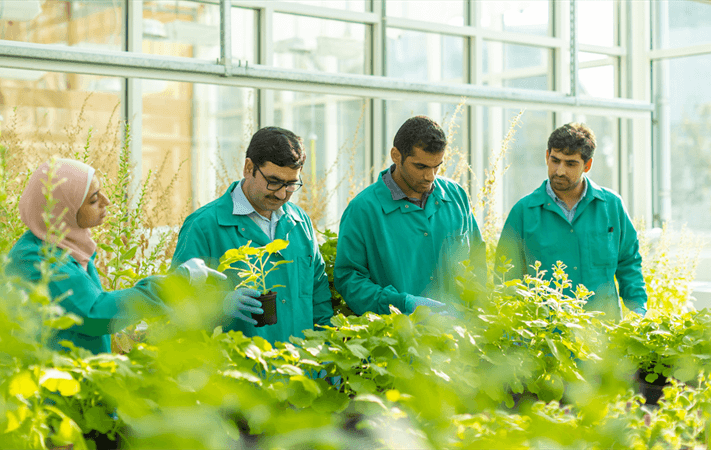‘Snip, edit, grow’ with gene editing techniques for improving food security

KAUST researchers—including those from Associate Professor Magdy Mahfouz's research group—work to improve gene editing tools for crop bioengineering. File photo.
By Sonia Turosienski, KAUST News
The Earth's increasing population and changing climate pose major threats to food security. Experts estimate that the world's population will reach 9.7 billion by 2050, with higher temperatures and changes in rainfall adversely affecting crop yields in many regions.
Countering this threat will require plant researchers and crop breeders to increase yield—that is, the amount of food a plant can produce. However, they must also decrease losses by making crops more resistant to disease and changing environmental factors. One of the most promising solutions to this dual challenge is genome engineering via gene editing, which allows targeted improvement of the key genes regulating the factors that contribute to yield and stress tolerance.

Researchers examine plant specimens in one of the University's greenhouse facilities. File photo.

KAUST Associate Professor Magdy Mahfouz and his research team from his Genome Engineering Lab are pictured here on the University's campus. File photo.
Sharpening the molecular scissors
CRISPR/Cas9 gene editing uses the Cas9 protein as "molecular scissors" to cut the DNA at a specific site. This break in the double-stranded DNA may disable a gene, create a new mutation once it is repaired or provide a place for a new gene to be inserted.

A KAUST researcher works in Associate Professor Magdy Mahfouz's Genome Engineering Lab on campus. Photo by Sarah Munshi.

KAUST Associate Professor Magdy Mahfouz believes the applications of gene editing may help reshape the future of agriculture. Image courtesy of Shutterstock.
To facilitate the generation of gene-edited plants that do not contain foreign DNA, Mahfouz and his lab are working on a new germline engineering platform that targets a specific cell and does away with the time-consuming tissue culture process.

KAUST Associate Professor Magdy Mahfouz's research group works on germline engineering to produce gene-edited plants without foreign DNA. Image courtesy of Shutterstock.

Magdy Mahfouz, KAUST associate professor of plant science, believes 'germline engineering [for plants] has the potential to save a lot of time, money and effort,' he stated. File photo.
The GMO controversy
A recent decision from the European Court of Justice ruled that crops created using CRISPR/Cas9 would be classed as genetically modified organisms (GMO) and be subject to stringent regulations in Europe. However, the research community has challenged this decision.

Genetically modified organisms—including crops produced from bioengineered plants—have caused controversy worldwide. Image courtesy of Shutterstock.
While Europe has taken a more conservative approach, in the U.S., CRISPR-edited mushrooms are already in the market.

In the United States, mushrooms produced by the gene editing technique CRISPR are already sold in supermarkets. Image courtesy of Shutterstock.
"There are ethical issues to consider, of course...but the big difference in agricultural applications is that the gene editing machinery is precise and can be separated out, so the resulting crop has no foreign DNA and is indistinguishable from conventional varieties."

